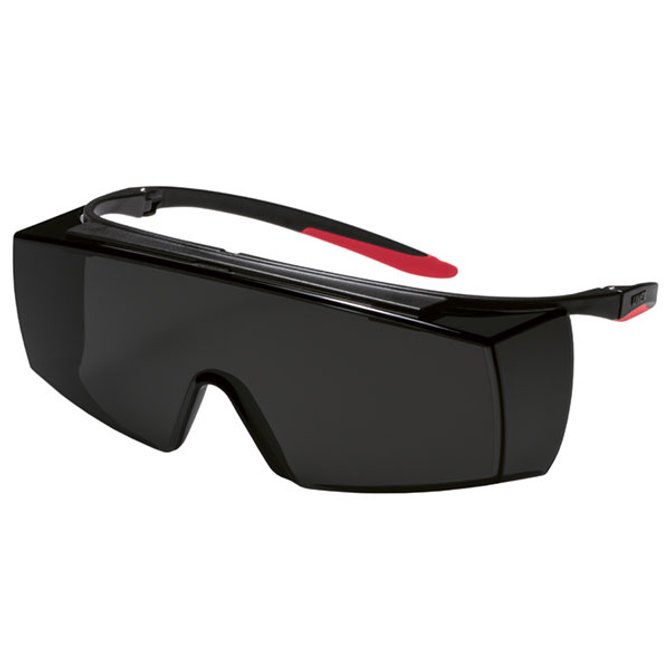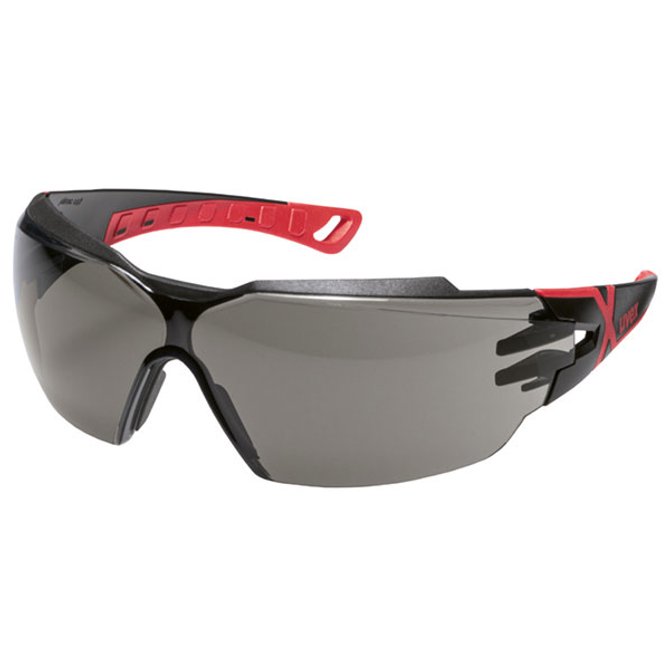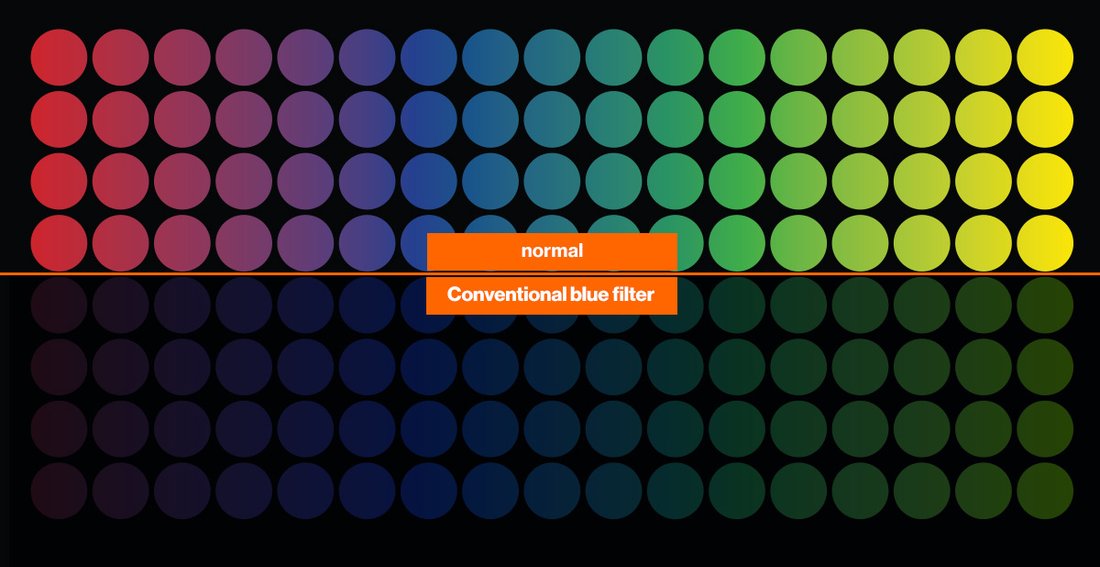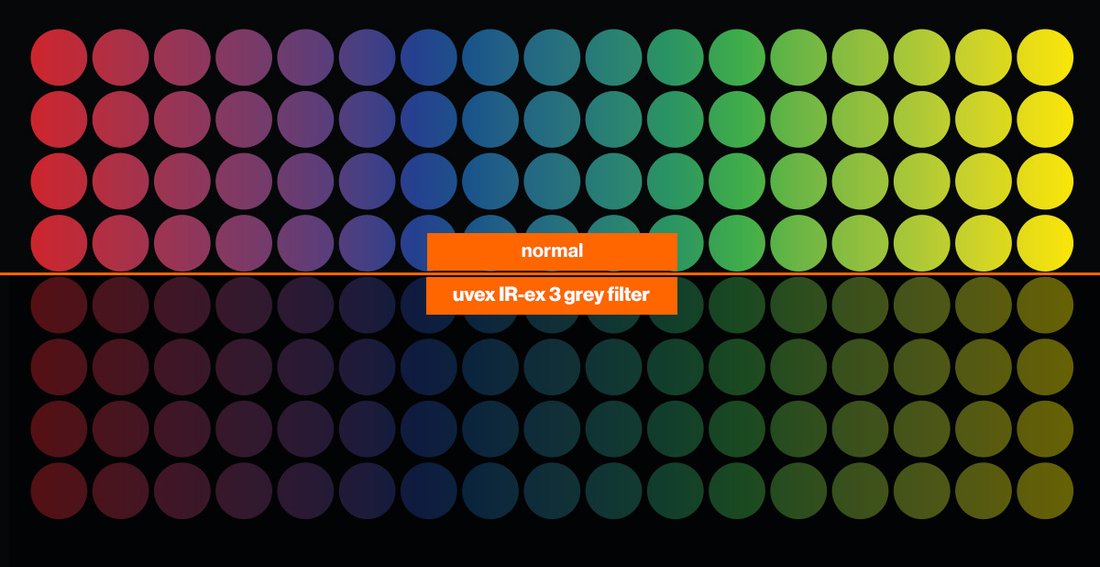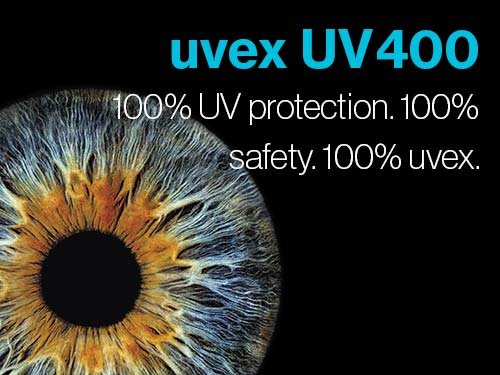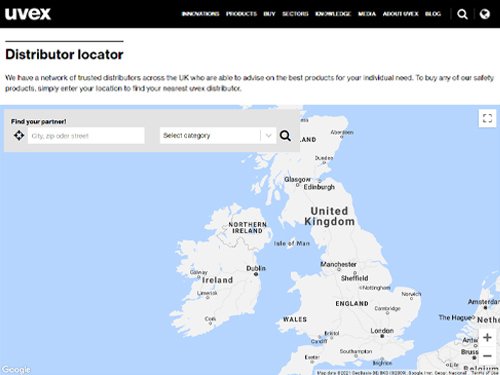uvex IR-ex protects the eye
Intense infrared radiation is present in many workplaces, from the metal, steel, ceramics and glass industries to sectors in which artificial IR emitters are used for hardening and drying, for example.
To provide effective protection for the sensitive human eye, uvex has developed the innovative IR-ex technology for safety eyewear.
This offers reliable infrared protection in accordance with EN 171 while simultaneously providing flawless visibility thanks to proven uvex supravision coating technology.

Infrared — The invisible danger
Infrared radiation (IR radiation) is often perceived as heat and extends over the wavelength spectrum from 780 nm to 1 mm. Similar to UV radiation, the human eye cannot perceive infrared radiation. People use sun cream and wear protective clothing and sunglasses to protect themselves from natural UV radiation of the sun. However, infrared radiation only occurs in specific professional contexts, meaning there is less awareness of the potential risks.
The three spectra of IR radiation:

IR-A (780 nm–1400 nm)
Can reach the retina and fatty tissue
IR-B (1400 nm–3000 nm)
Only penetrates through the blood vessels to just before the beginning of the fatty tissue
IR-C (3000 nm–1 mm)
Reaches only the surface of the skin and cornea

UV400 protection included
IR radiation, like UV radiation, cannot be perceived by the eye and therefore carries hidden health risks. uvex IR-ex occupational safety spectacles are available with the levels of protection 1.7/3/5. Their high light transmission in the visible range combined with 100% UV400 protection make their performance truly impressive.
| uvex UV400 |
uvex super f OTG

4C-1,7 W1 FTKN (EN 171)
The uvex super f OTG are comfortable safety spectacles providing excellent eye coverage. The unique frame design fits comfortably over most prescription spectacles making them a low cost alternative to safety prescription eyewear and suitable for site visitors.
uvex pheos cx2

4C-1,7 W1 FTKN (EN 171)
Optimal eye protection in any situation: the soft browguard component is injection moulded onto the lens and keeps dust and liquid splashes out of the eyes. The innovative uvex x-tended eyeshield offers additional protection.

Perfect colour recognition and signal light detection
The tint of the uvex IR-ex lens is truly innovative in the field of infrared safety eyewear: Instead of green or blue, as used in conventional models, the lens is tinted grey — this was previously only offered for classic glare protection eyewear or for some welding safety eyewear. This significantly improves colour recognition and allows for the clear detection of coloured signal or warning lights.


uvex IR-ex safety spectacles for your workplace
The exceptional protection and vision features offered by uvex IR-ex safety eyewear makes them suitable for use in a wide range of industries: for example, for quality control for incandescent objects or in environments with high levels of artificial infrared lighting. They can also be used as welding safety eyewear in accordance with EN 169. Thanks to the attractive pricing and their long service life, uvex IR-ex safety eyewear is also a great economical choice.
Infrared radiation is not visible to the human eye. It is also known as heat radiation and ranges in the electromagnetic spectrum from 780 nm to 1 mm (1,000,000 nm). The best known natural source of infrared rays is the sun — they account for approximately 50% of the sunlight that reaches our Earth. In many workplaces, infrared radiation is produced by artificial sources such as incandescent objects and radiant heaters.
Infrared radiation was discovered by the astronomer Friedrich Wilhelm Herschel in 1800. His experiments helped him discover that light and infrared radiation are the same phenomenon — electromagnetic radiation. Infrared radiation is divided into three spectra:
- IR-A (780 nm–1400 nm)
- IR-B (1400 nm–3000 nm)
- IR-C (3000 nm–1 mm)
When infrared radiation penetrates human tissue, it can cause damage. This follows a principle: the larger the wavelength, the smaller the penetration depth into the tissue. The human eye is particularly at risk from infrared radiation.
IR-A radiation has the greatest penetration depth and can reach the retina and fatty tissue.
IR-B radiation only penetrates the blood vessels to just before the beginning of the fatty tissue.
IR-C radiation only reaches the surface of the skin and the cornea.
If the lens of the eye is exposed to heat via infrared radiation, this can lead to cataracts. The retina is also at risk — irreversible damage can occur if the tissue heats up too much.
People are exposed to stronger or weaker infrared radiation depending on the workplace. Temperature and light effects provide a first impression of the potential risk:
| Temperature | Colour impression | Example | Potential risk |
| 200°C | No visible light | Oven, IR surface heater | None |
| 500°C | Initial red heat | Electric grill | Initial risk to lens and cornea |
| 1500°C | Blinding white heat | Molten iron | Risk to retina, lens and cornea |
| 5500°C | Neutral white | Sun | Risk to retina, risk to the skin, lens and cornea from UV radiation |
Protection against infrared rays is not only required in foundries or blast furnaces where extreme temperatures prevail. Industrial radiant heaters or lighting systems can also generate infrared radiation that is harmful to the eye.
| Workplace | Note | Safeguards |
| Smelting plants, foundries | Threshold value for the eyes will likely be exceeded: the hotter the molten metal, the greater the risk (molten iron: 1450°C, molten aluminium: 750°C). | Use of shielding, minimising exposure time, use of personal protective equipment (IR safety eywear/visors, protective clothing). |
| Blast furnaces | Threshold value for the skin and eyes may be exceeded (1600°C). | Use of shielding, visors and appropriate protective clothing. |
| Glass processing, glass production | Threshold value for the eyes may be exceeded, especially when staying in front of the heating drum and the glass furnace (the level of exposure depends on the temperature of the radiation source), UV radiation also occurs during glass processing with gas flames. | Use of shielding, personal protective equipment (IR safety eywear without colour distortion). |
| Industrial IR emitters | Threshold value for the eyes may be exceeded (depending on the distance and duration of exposure). | Use of shielding, personal protective equipment (IR safety eyewear). |
| Open flames | Threshold value for the eyes is exceeded when staring at the flames for long periods from close range. | Wearing personal protective equipment (IR safety eyewear) |
| IR radiant heaters in catering | Strong IR emitters (2 kW) are very often used for heating purposes. If the emitter is close enough (20 cm), the threshold value for the eyes is exceeded after a short time (< 10 s). | Appropriate distance from the heater, no direct staring. |
To protect the eye from dangerous infrared radiation, it is essential to wear suitable safety eyewear in many workplaces. Certified personal protective equipment in accordance with DIN EN 171 is strongly recommended. For example, for work requiring the prolonged or repeated viewing of glowing objects, wearing suitable safety eyewear is essential.
Levels of infrared protection and recommendations for use in accordance with EN 171
| 4-1.7 | Average temperature of the radiation source up to 1090°C |
| 4-2 | Average temperature of the radiation source up to 1110°C (forges) |
| 4-3 | Average temperature of the radiation source 1190°C (glass blowing) |
| 4-4 | Average temperature of the radiation source 1290°C (foundries) |
| 4-5 | Average temperature of the radiation source 1390°C (steel foundries) |
| 4-6 | Average temperature of the radiation source 1510°C (iron foundries) |
During welding, the eyes must be protected against intense visible radiation - and at the same time, the luminance of the welding arc must be reduced to a sufficient level to enable the welding process to be observed glare-free.
Infrared protection is required for work where there is exposure to high thermal radiation that is not visible. In addition to protective equipment such as vision shields in the workplace, wearing infrared safety eyewear is required.
Therefore, requirements for eye protection filters vary: The DIN EN 169 standard is defined for welding protection, while DIN EN 171 applies for infrared protection. uvex IR-ex infrared safety eyewear meets both standards — and can therefore also be used for welding.











